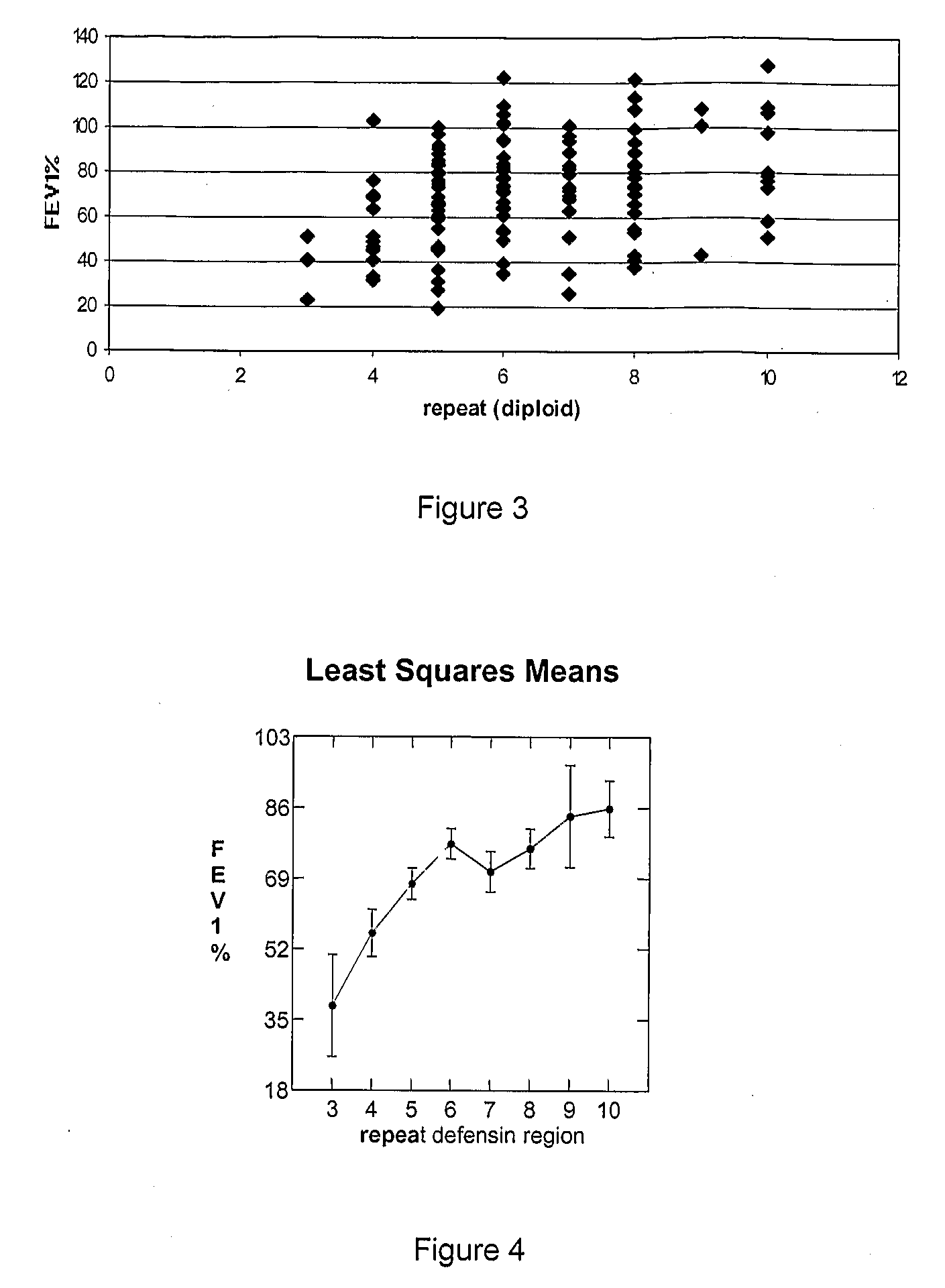Tools and Methods for the Quantification of Dna Repeats
a technology of repeats and tools, applied in the field of assay methods, can solve the problems of prawn to pipetting errors, inability to tolerate, and inability to accurately determine the dna copy number of a given sequence in a large number
- Summary
- Abstract
- Description
- Claims
- Application Information
AI Technical Summary
Problems solved by technology
Method used
Image
Examples
example 1
Development of an Assay System for the Quantification of the Copy Number of the Genes Encoding hBD2-6 and its Use in the Study of the Genetic Basis of Cystic Fibrosis
Studied Populations
[0034]For the cystic fibrosis association studies, 47 Belgian, 37 South-Italian and 52 Czech CF patients were investigated. Only CF patients homozygous for the F508del mutation were included, in order to minimise the effect of variability of the CFTR genotype on the CF phenotype. The FEV1 values, which are a measure of lung function, were taken from the clinical records of the patients. Only the disease status at a small age range was studied, i.e. the age of the patients varied between 11 and 15 years, in order to normalise for age. The FEV1 values were normalised to FEV1% according to Knudson et al. [6].
Preparation of the Control Constructs
[0035]In a molecular biological assay, the copy number of a gene that is part of repeat should be determined relatively to a gene that is not part of that repeat....
example 2
Effect of the Copy Number of the Genes Encoding hBD2-6 in a Study on the Genetic Basis of COPD
Studied Populations
[0047]For the COPD association study, 69 healthy Belgian smoking control samples and 44 emphysema patients were compared.
Results
Analyses of Individuals
[0048]The diploid hBD2 copy number was determined in 69 Belgian smoking control patients and 44 Belgian COPD patients. All TaqMan experiments were independently performed 3 times. On each 96-well plate, all tests were performed in duplo and contained all control constructs, so that a standard curve was made for each experiment / plate. Over the three experiments the standard deviation of the amount of repeats was less then 1.
COPD Association Study
[0049]The study showed that emphysema patients had more repeats than control individuals (P-value=0.006)
example 3
Correlation of hBD2 Transcript Levels with the Number of hBD2 Repeats
Tissue culture of nasal epithelial cells
[0050]Nasal polyps were obtained from about 50 patients having rhinosinusitis, in whom polyps were removed for medical reasons by a surgical intervention. From these tissue samples, monolayers of epithelial cells were grown as described before [7]. Immediately after surgical isolation, the tissue samples were placed in Dulbecco's Modified Eagles Medium (DMEM) (Invitrogen), supplemented with 100 U of penicillin (PE) (Invitrogen) and 100 mg / ml streptomycin (ST) (Invitrogen), before transportation to the laboratory. After washing the tissue samples 3 times in a sterile saline solution (0.9% NaCl) containing PEST, the samples were cut into small pieces (using a sterile surgical blade) and placed on a tumble mill in a container with a solution of pronase (1 mg / ml) (Sigma) for 16-24 h in a cold chamber (4° C.) to enable enzymatic dissociation of the epithelium. After gentle shaking...
PUM
| Property | Measurement | Unit |
|---|---|---|
| Fraction | aaaaa | aaaaa |
| Fraction | aaaaa | aaaaa |
| Fraction | aaaaa | aaaaa |
Abstract
Description
Claims
Application Information
 Login to View More
Login to View More - R&D
- Intellectual Property
- Life Sciences
- Materials
- Tech Scout
- Unparalleled Data Quality
- Higher Quality Content
- 60% Fewer Hallucinations
Browse by: Latest US Patents, China's latest patents, Technical Efficacy Thesaurus, Application Domain, Technology Topic, Popular Technical Reports.
© 2025 PatSnap. All rights reserved.Legal|Privacy policy|Modern Slavery Act Transparency Statement|Sitemap|About US| Contact US: help@patsnap.com



